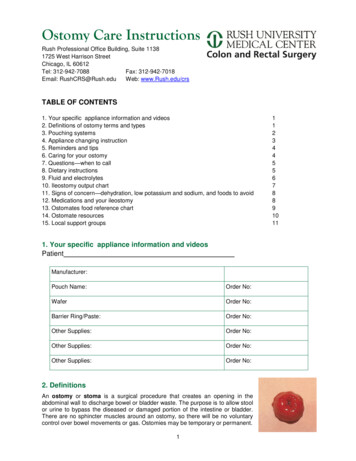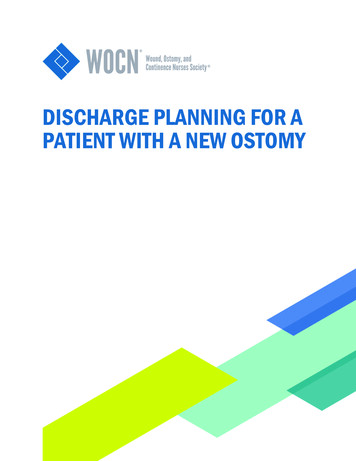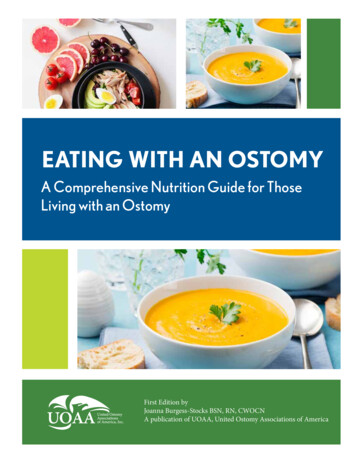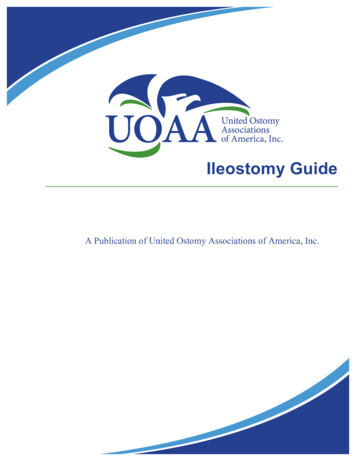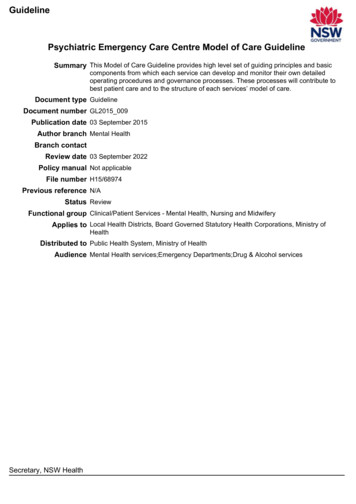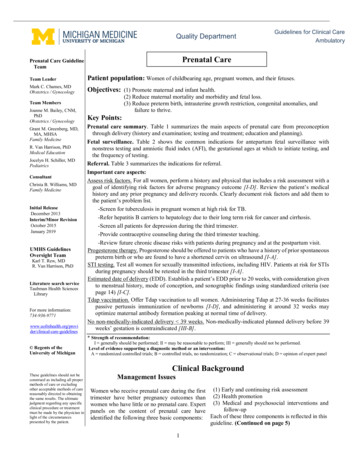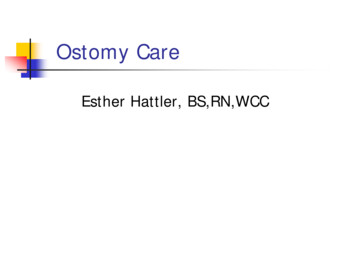
Transcription
Ostomy CareEsther Hattler, BS,RN,WCC
Objectives Recognize the 3 basic types of ostomies
Ostomy EducationWHAT IS OSTOMY EDUCATION?
Ostomy definition An ostomy is a surgical procedure thatinvolves the removal of diseasedportions of the gastrointestinal orurinary system and creation of anartificial opening in the abdomen toallow for the elimination of bodywastes.
Frequency of Ostomies More than 700,000 Americans – frominfants to senior citizens – have hadostomy surgery.Over 120,000 people each year havefecal or urinary ostomies.
Why an ostomy? An ostomy procedure is essential for:Colorectal cancer, bladder cancer, Crohn’sdisease, ulcerative colitis, birth defects, andother intestinal or urinary medical conditions.Also, ostomies are necessary in certain casesof severe abdominal and/or pelvic trauma. Inrecent years, there has been an increase insuch traumatic injuries suffered by soldiers onactive duty in the military.
Life Changing! For individuals suffering from suchconditions, ostomy surgery is both lifesaving and life-changing
What is an ostomy? It is a surgical opening in the abdomenwhere the intestine is brought up onto theskin and sutured in place to form a stoma.To bypass diseased intestine or bladder3 types; the most common is the colostomyThen the ileostomyAnd last the urostomy
3 types of ostomies Colostomy Ileostomy Urostomy
Colostomy is from colon
Indications for a colostomy TraumaCancerDiverticular diseaseCrohn’s diseaseUlcerative colitisObstruction
Gastrointestinal System
Colostomy Portion of diseased large intestine(colon) is removed or by-passedRemaining portion is brought throughthe abdominal wall to form the stomaMay be temporary or permanentIf temporary, stoma will be necessaryuntil the disease portion can healRequires another surgery to reconnect
Colostomy sites
View
New stoma
Hard to pouch stoma
Ostomy care Empty pouch when 1/3 to ½ fullChange pouching system 2x/week orimmediately for any leakingMay shower with appliance on or offDo not use baby wipes to clean aroundstoma .new wafer may not stickClean peri stomal skin with moist washcloth
Skin cleansing WaterSoap discouragedNo diaper wipes (lanolin)Product wipes made for adherence ifneededLess is moreOstomy products are made to adhere tothe skin!
Measure stoma They can change in size After surgeryWeight gainWeight loss
How to make appliance fit Use correct size of applianceCut to fit each individual stomaThe wafer (adhesive barrier) should fitsnugly around the stoma, 1/8” closeUse barrier ring or paste only ifnecessarySome newer wafers are “form to fit”and they turtle neck up to stoma
Cut to fit wafer
Stretch to fit appliance
Types of StomasBuddedFlushInverted
Peristomal skin breakdown
Crusting technique Clean dry (if possible) skinApply stomahesive powder; sprinkleDust off with gauze, paper towel etcDab with no sting barrier wipe/lollipopRepeat process 3 timesKeep effluent off peristomal skin whileapplying the crusting technique
Healthy Stoma
Paste/barrier rings Paste has alcohol; if needed let dry for1 minute for evaporation of alcoholbefore applying to skinBarrier rings preferred; warm first applyto skin, can fill in crevices and provideprotection of peristomal skinFit right next to stoma
Barrier ring application
Stomahesive Paste
1 or 2 piece, matter of preference
Convex Use if stoma is flush or inverted
Drainable or closed Urostomy pouch has to be drainableIleostomy pouch has to be drainageColostomy pouch can be closed end ordrainableMedicare provides 20 wafers and 20drainable pouches per monthOR 60 closed end pouches
Pouches Closed end Drainable
Two piece
One piece
Ileostomy Stoma that comes from the ileumUsually on the lower right of abdomenEffluent is loose to liquid with enzymesMore issues with leaking and breakdown in peristomal skinMore diet restrictionsBlockage problems
Ileostomy site
Ileostomy stoma
Ileostomy is from the ileum The entire colon, rectum and anus areremoved or bypassedThe small intestine (ileum) is broughtthrough the abdominal wall creating thestoma, most often on the right lower siteThe stoma is smaller in diameterEffulent is loose to thin and more difficultto contain
Ileostomy diet Drink much more water/liquids; 10-12glasses a dayAvoid nuts, popcorn, seeds, celery, cornRaw crunchy vegetables must bechewed very well!Eat slowly and chew all food wellAvoid time release/enteric coated pillsFor blockage-go to ER
Ileostomy tips For difficulty/constantly draining stomaHave patient/client eat 2 Tablespoonsof peanut butterOR eat 6 large marshmellows30 minutes before changing applianceThis will slow down the drainage so youcan get a good seal
Urostomy The bladder is removed or bypassedA conduit is made of small intestinetissueUreters are implanted into the ileumand on to the urostomy stomaThe urine flows from the stoma into thepouching appliance
Ileal Conduit
Urostomy tidbits The intestine produces mucous,therefore the urine will have a cloudyappearance and the mucous will needto be cleaned off the stoma duringappliance changesAdequate fluid intake, 8-10 glasses aday, is very importantNeed to connect to a over nightdrainage system at night
Urine crystals White, gritty deposits on and aroundstomaClean with peristomal skin with 1:1vinegar and waterClean over night container with vinegarand water
Percentages of the 3 types Urostomy20% Ileostomy35% Colostomy45%
Questions?
Resources United Ostomy Associations of America,Inc. (UOAA) 1-800-826-0826www.ostomy.orgWound, Ostomy, Continence NursesSociety (WOCN) BQ Ostomy support group 505 830-2135
Resources Turnbull, Gwen B. RN,BS,”OstomyStatistics: The 64,000 Question”,Ostomy wound Management Journal,Volumne 49, Issue 6, June, 2003(issue/26)Cooke, Colin, “American OstomyCensus”, The Phoenix, December 2009.
Why an ostomy? An ostomy procedure is essential for: Colorectal cancer, bladder cancer, Crohn’s disease, ulcerative colitis, birth defects, and other intestinal or urinary medical conditions. Also, ostomies are necessary in certain cases of severe abdominal and/or
